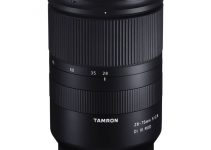In the last year, a lot of rumors have been circulating about Panasonic being ready to unveil a completely new mirrorless camera, something more focused on video. The rumors were somehow confirmed when a few months ago Panasonic itself teased the existence of such a device.
Finally, the announcement came, and we now have a new full-frame mirrorless camera, specifically aimed at video professionals – the DC-S1H. This new body promises a lot of features and details that will make our life much easier. Now, we will try to discover them with Carl Yates at ProAV TV who has already got his hands on this brand new camera and will tour us around for a first look.
With this latest addition, the S lineup now consists of three cameras, each one with a specific user in mind. The DC-S1 is the hybrid multi-purpose camera for those whose work dwells in both photo and video and need to be good in either one. The S1-R, on the other hand, is dedicated to photographers. The sensor has a higher MP count and a few features are useful in still photography.
Finally, the DC-S1H closes the circle bringing a specific product for video-shooters. In a nutshell, it seems to be almost the perfect camera: custom-designed body, Dual ISO, 6K recording, unlimited rec time, sensor stabilization… Seems too good to be true. Or is it?
This approach of dividing the lineup may seem similar to what Sony was doing with the Alpha series, but Panasonic actually went down a very different route. The body, in fact, is not the same throughout the different cameras as the A7S’s and R’s are.
The S1H is much beefier, it has a completely different cooling system (with vents!), thus allowing great video performance, but also keeping the same photographic specs as the other models. As a direct consequence of the improved cooling, the camera doesn’t have a recording limit. That alone puts it in a completely new league, far away from other mirrorless competitors.
The big boasting feature that probably caught everyone’s eye is the 10-bit 6K recording. To be fair, it’s limited to a 4:2:0 color sampling that becomes 4:2:2 if you go down to 4K, but still it’s a 10-bit 6K recording at less than $4K!
The file is a Long GOP with a bitrate of 200MB/s, the same we’ve seen in other Panasonic cameras, but is only available if shooting internally. Keep in mind that if you plan on using the HDMI port for recording, you’ll find that the signal will cap at 4K.
Unfortunately, that seems to be a limit of the HDMI standard. As manufacturers will start adopting the HDMI 2.1 (that supports up to 10K 120fps) we will have to make do with this limitation.
With the S1H the XDQ slots are gone in favor of a more universally accepted SD card slot. This choice of moving away from XQD cards will meet the favor of many of us that already own plenty of SDs, but we must note that the XQD was a great media to record to, surely tougher than the SD.
The stabilized sensor is on par with the great performances we saw in the previous iteration, as isn’t, unfortunately, the case with the onboard autofocus system. Panasonic’s contrast-based AF is still quite far from the quality and speed of phase-detection AF seen on Canon or Sony systems.
Filmmakers expected Panasonic to catch up on this technology as the gap between the two systems is already wide enough, Maybe the next iteration of cameras will bring the update, who knows…
Nevertheless, there are a lot of small details that show how much thought has gone in the design of the DC-S1H, and how much the feedback of users has been heard.
The status screen (designed for video shooting to show your main settings and allow you to quickly change while you use an external monitor), the tally light, or the fully rotating and articulating screen that surely had pretty good engineering behind. What’s more, you can rotate and tilt the latter freely without the fear of moving or touching the cables connected on the side of the body.
But it doesn’t end there. The list of features is endless, and in a first hands-on we have to gloss over so many. Yates did not even talk of the native dual ISO or the anamorphic de-squeeze. What gets clear trough this first look, however, is that the Panasonic S1H can be a game-changer for videographers all over the world.
Almost all the specs we would expect from bigger and pricier cameras have been shrunk into this small body, thus making our filmmaking workflow every day a little bit easier. Can you imagine what we’ll get next?
[source: ProAV TV]
Order Links:
Panasonic Lumix DC-S1H Mirrorless Digital Camera (B&H, Amazon)
Disclaimer: As an Amazon Associate partner and participant in B&H and Adorama Affiliate programmes, we earn a small comission from each purchase made through the affiliate links listed above at no additional cost to you.



